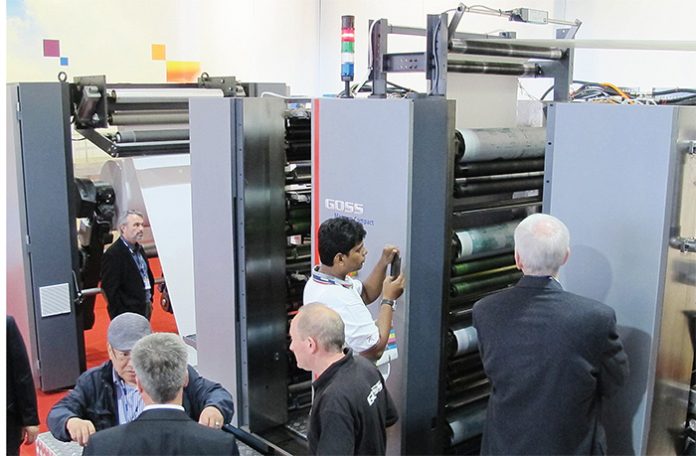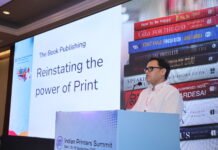
In March and the beginning of April 2014, Goss showed its Magnum Compact press tower as a running printing system at the Goss factory in Shanghai. Shown running to customers and to its own teams from around the world and to the trade media, this was the running system based on the tower that Goss unveiled at China Print in Beijing in May 2013. At the time, Goss said it would show a running system in the last quarter of 2013.
Considering that this is a radical and new design, (although it does borrow from the Goss FPS and substantially uses many of Magnum components) the delay is trivial. In the meantime, Goss in the US has actually sold six towers of the 2 x 1 Goss Magnum Compact to Advance Publications, a Staten Island New York newspaper publisher and contract printer for installation in the fall of
this year. The side frames and other components for the New York order were being machined during our visit at the beginning of April in one of a series of visits by customers in the past month. Several customers from India have shown interest in the new Magnum Compact and during our visit we met up with Goss customers from the US, Canada, Malaysia, Vietnam and India who came for a look at the first running Goss Magnum Compact system.
A single-width automated press
To restate much of what we said last year after seeing the Magnum Compact tower at China Print in Beijing, is that it is the key component in building a highly automated 2 x 1 web offset press system that uses less
space and less manpower and is able to produce full color newspapers and books in relatively short runs. The low-
height tower incorporates shaftless motors and simultaneous automated plate loading as standard — whereby all the eight plates in a tower can be changed within 30 seconds including the full sequence of old plate removal and new plate loading.
This is a one level press and a single step (mounted on the side frame) is needed only for placing a new plate in the tray of the top print couple. Shown running with an autopaster and folder in a single tower system at Shanghai, the press can run at 50,000 copies an hour. The web infeed from the bottom of the tower has its own shaftless drive for positive tensioning control. Altogether each tower has seven shaftless motors.
The 4-Hi tower has been reduced in height to 2.2 metres by slicing it vertically into three parts — a centre section which holds the four pairs of
blanket to blanket cylinders on
bearers and the two sections on either side that include the inkers, the autoplate device and the plate cylinders. The shaftless motors accompanied by electronic controls and optional remote ink presetting closed loop registration and cut-off minimize makeready time and paper waste. Automation features include webbing up, spraybar dampening, pneumatic ink train wash-up and automatic ink levelling. The two side sections mounted on rails easily move apart for maintenance.
The Goss Magnum Compact towers are being offered for web widths of 889 mm and can be built for webs as wide as 1016 mm. Cut offs that are being offered are 533, 546, 578 and 630 mm. Existing Goss folders including the J12, J122 and J133 are being offered although we hope that the company will also develop a suitably low height folder to go with the Compact theme.
The new press has been designed from the ground up for automation with a CIP4 enabled press console from Omincom, drives from B&R, Rexroth and Siemens; PLCs and controls from B&R Automation for sequential motor control for stop, start and automated plate changes. The entire printing system is actually computer driven and all functions and events are logged and can be accessed by an MIS system on the press or remotely by Goss engineers.
Where does the Goss Magnum Compact fit as far as the Indian print industry? It could work for newspaper publishers or newspaper contract printers who want to print high quality color on newsprint on all or a majority of pages in centres where the circulations are less than 150,000 or even 200,000. At least for many language newspapers, such runs do not justify the cost of a 4 x 1 installation with its space, mailroom and training requirements. The Compact could well take advantage of the comfort level of Indian newspapers with 2 x 1 presses.
Although Goss claims the press can work for print runs from 500 to 250,000, the Magnum Compact may fit well in newspaper contract printing plants where several dailies and their color supplements are produced each day. In India the number of contract printing plants is still relatively low but it is likely that these will increase and the automated Compact may find a market in newspaper plants that already print several small remote editions of larger dailies apart from their own newspaper.
The new Goss Magnum Compact is also interesting to book printers where the web offset runs are getting shorter and the efficiencies of quick changeovers and makereadies can bring down costs in conjunction with a quarter or double parallel folder. Available in several cut-off options the new press speaks volumes to those newspapers who continue to be comfortable with 2 x 1 web offset presses for a variety of reasons but are also keen to increase quality and efficiency with modern automation tools.
















